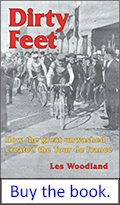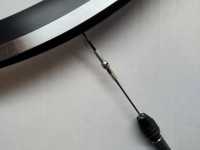

The Best Way to Measure ERD
(Effective Rim Diameter)
by John Neugent
Tech articles | Commentary articles
John Neugent probably knows more about bicycle wheels than anyone else alive. Maybe more about bikes as well. He's spent his life in the bike business, at every level. He now owns Neugent Cycling, a firm devoted to delivering world-class equipment at the lowest possible price. If you are in the market for a set of wheels, please, check out John's site. He really knows his stuff. —Chairman Bill

John Neugent

Les Woodland's book Dirty Feet: How the Great Unwashed Created the Tour de France is available in print, Kindle eBook & audiobook versions. To get your copy, just click on the Amazon link on the right.
John Neugent writes:
When building a wheel, it’s imperative to know the effective diameter of a rim. Sometimes the rim maker will tell you but not always. At any rate if you want to build a wheel or wheels you need that information to determine spoke length. On YouTube you can see many different ways but most of them leave out one critical piece of information.


INSERT SPOKE MEASURING KIT AND NIPPLETHREADER
This image show my home made kit for measuring. There are two spokes of the same length, a rubber band, a spoke with a nipple screwed on, and a Vernier caliper (oops – forgot the Vernier caliper). The key part is the spoke and nipple. You want to thread the nipple on until about 1.5 mm of the spoke extends through the nipple. In most cases this will give you the same ERD and the rim maker will give you. Using this easy to make tool means the spoke will thread onto the nipple enough to get maximum strength. If the spoke doesn’t thread in enough the nipple is more likely to crack.


INSERT USING SPOKE THREADER AND SPOKE LENGTH CALCULATION
Put the spokes on opposite sides of the rim and connect the spokes with the rubber band. Measure the distance between the two spokes and add up the total distance. I normally use two 260 mm spokes. Spokes are normally 1 mm shorter than the nominal size so a 260 mm spoke will actually measure 259 but they are going to stretch when you tension the wheel. Using the 1.5 mm tool gives you consistency. Make sure you bottom the nipple on the tool and screw it onto the threads until it hits the end of the spoke.
.jpg)
INSERT FRONT WHEEL TEST
Two other neat tricks that I always use when building with new rims or hubs is a quick check to double check spoke length. I build all non-disc front wheels with radial spoking. I double check the length by putting two spokes into the front hub opposite each other and tighten the nipple using the 1.5 mm tool. The rim should be near the middle of the hub flanges. I use radial spoking on the non-drive side of rear non disc wheels and you can do the same thing on the rear hub. If you use internal washers as I do on the drive side rear, make sure account for them by adding the thickness to the spoke calculation chart.
I use the Sheldon Spoke Calculator. I download it and save all of my different builds in separate files.
John Neugent was was one of the first to establish quality hand building in Taiwan around the turn of the century. He now owns Neugent Cycling, a firm devoted to delivering world-class equipment at the lowest possible price.









